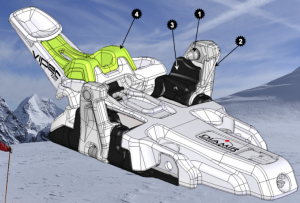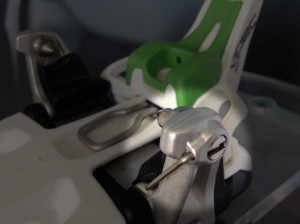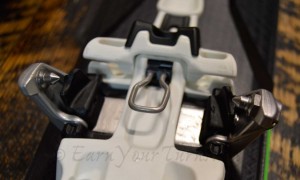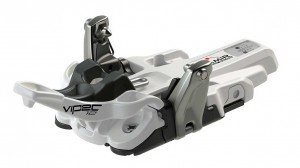
Vipec’s toe gets a make over.
1) Thicker pins: M5 to M6. 2) Spring-loaded locking pin.
3) Self centering jaws. 4) Improved toe clip
Based on feedback from retailers and early adopters, Fritschi’s Vipec, their first 2-pin tech binding, will see four modifications to the toe unit this season. The most noticeable change is to the pins, which will now be thicker, a tad longer, and with an improved adjustment locking mechanism. Less obvious, but perhaps more important, is the addition of plastic guides inside the pin arms to make getting in and out of the binding much easier. Lastly, a clip that snaps onto the toe release lever will now come pre-mounted for a better touring release with square-toed boots.
Introductory Woes
The Vipec is the first tech binding to provide lateral release at the toe. This capability requires the pins to set inside the inserts with a tighter tolerance than the dimensions of some inserts may allow. Insert dimensions may vary from boot to boot by as much as 1.2 mm. To account for that disparity Fritschi made the depth of the left pin adjustable by retailers installing the binding. Furthermore, retailers were expected to secure the lock nut on the pin with Loctite™ so it wouldn’t come loose after installation. Unfortunately, not everyone followed directions and early reports indicated pins were falling out in the field.
Field Repair
Fritschi responded immediately by shipping all bindings with Loctite™ already applied. In the majority of cases the pins don’t need any adjustment. If the pins didn’t seat properly in a boot, retailers were given instructions for making the adjustment and reapplying Loctite™ 263. This did resolve the problem of pins falling out, and raised awareness of the need to check the pin gap relative to a boots insert width.
The Fix
Based on requests by their global distribution partners Fritschi is upping the ante moving forward. New Vipec bindings now have the adjusting pin on the right side. The angular forces on the pin will now incrementally tighten the lock nut, not loosen it. Furthermore, in addition to Loctite™, a mechanical spring-loaded pin will hold the lock nut in place.
updated 06oct14
From early photos and diagrams provided I can only speculate this will act like a cotter pin. The photo above shows that the pin keeps the screw head locked in position. It also means the adjustment is limited to a half rotation, but that should be fine enough. (end update) And finally, even though there were no reports of mechanical pin failure the diameter of the pins will increase from M5 to M6, making them inherently stronger.
While these changes should calm any fears of pins falling out in the field, the issue more people noticed is Vipec’s version of fiddle factor for getting in and out of the binding. Molded plastic guides will now adorn the lower half of the pin arms to help center them about the boot. Fritschi claims this makes getting in and out easier. I haven’t actually tried it yet, but it looks like a solid improvement.At Vipec’s introduction two clips were available to add to the front release lever. These provided a surface for a boot to contact in the event of a forward fall to prevent the jaws opening up prematurely. Based on experience, the thicker clip will be included as standard, the thinner clip will be discontinued.
All’s well
Except for the toe clip, I reported on all these shortcomings in a comprehensive review of the Vipec in May 2014. It is great to see Fritschi offer improvements to address them. Alpine skiers don’t obsess over their bindings much since they tend to disappear once you’re in them. Touring bindings will never be that fortunate since they need to do more than merely hold onto your boot while sliding down a slope, they also need to hold on while letting you walk uphill too. With these improvements the Vipec is one step closer to becoming a commodity you can rely on without giving it much thought.
The potential for snow to creep inside the heel unit remains, and unless you tour where the snow is routinely damp, this should be a rare condition. If it does happen it will be difficult to either lock the heel in downhill mode, or vice versa. To fix that, you need to remove the snow, either by removing the heel unit from the slider track to clear it out, or knocking it loose, or waiting for it to melt out. In any case, don’t force it or you’ll break the black lever arm.
More credible commentary to follow later this winter after a pair of the updated Vipec’s are given a real field test.
© 2014
Related Posts
Devilish Details of Fritschi’s Vipec
First Look: Fritschi’s Vipec




7 pings
Skip to comment form
[…] toe bumpers, but patents probably make that unpalatable to the bottom line (Editor’s note: This has been addressed). Even so, it could make getting in easier and more reliable. Can potential icing issues be […]
[…] Posts Fritschi Fixes Vipec’s Toe Woes (October 2014) Devilish Details of Fritschi’s Vipec […]
Thank you for the article.
Great blog that I enjoyed reading.